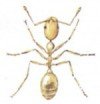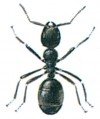

The pharaoh ant is an African species that first appeared in Northern Europe nearly 100 years ago. It is omnivorous, but can only survive in warm and humid environments. Its basic life demands are very similar to those of cockroach and it also live in the places where you would expect to find cockroaches. This ant’s small size and the large number of individuals which exist in a colony, allow the pharaoh ant to reach far in large facilities. The common black ant is not synanthrope anywhere because it depends on aphids. Normally it lives outdoors, but in cases where a colony is located below or adjacent to a heated house, the slightly higher temperature can cause the ants to become active earlier in the spring than it normally would. It forces the common black ant to find its food indoors until it gets warmer and aphids appear outside.
The above mentioned examples (1) – (8) show that Synanthropy both qualitatively and quantitatively is made up by the interaction between the biology of the insects and the local climate offered to them. Usually there will be some continuity in the individual species’ spread from warmer regions to cold temperate zones in which we live. However, there are a few exceptions and one of these is the dark flour beetle.




